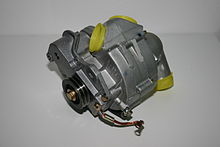G-loader
The G-Lader is a scroll compressor - i.e. a machine for compressing gases - that was installed in various Volkswagen models (first in the Polo , later also in the Passat , Golf and Corrado ) in order to increase the engine 's performance while maintaining the same displacement increase.
The name “G-Lader” comes from the shape of the charger, which is similar to the letter “G”.
history
On October 3, 1905, the Frenchman Léon Creux patented this type of air compressor (US patent number 801,182), which is characterized by low operating noise and high efficiency . Due to the very imprecise manufacturing methods at the time, however, it could not be manufactured for a long time, since the displacer in the loader, for example, approaches the housing wall to a hundredth of a millimeter without touching it. Only with the state of the art in the 1980s was it possible to manufacture the G-Lader at a reasonable cost.
In 1978 Volkswagen took up the idea of the G-Lader and in 1987 brought the Polo G40 onto the market, initially in a limited number of 500 units. Then the Golf, the Corrado and the Passat with G-Lader were also offered.
On July 1, 1989, Georg Jetzer had a “displacement machine based on the spiral principle” patented by the European Patent Office .
functionality
There are various ways of increasing the performance of internal combustion engines. One of these is to increase the pressure in the intake manifold, either with a compressor or a turbocharger. This increases the throughput, more fuel-air mixture is processed at a given speed and the torque is higher. The G-Lader works with internal compression, as the medium is compressed within itself; in contrast to the turbocharger , in which the pressure is only built up in the connected volute casing.
In the charger housing is the so-called displacement plate (displacer) with spirals on both sides, which is made of magnesium. The charger housing itself also contains volutes on both sides that mesh with those of the displacer. The displacer moves, driven by the eccentric shaft , which is connected to the displacer shaft by a small belt , on a small circular path without turning itself. The almost contact points of each displacement spiral with the respective fixed spiral migrate inwardly; the chambers located between these points convey and compress air up to a maximum final pressure of 0.65 to 0.72 bar . In the middle of the G-Lader is the exhaust duct through which the air flows into the intake tract.
advantages
An engine with a G-charger has a better response than a conventional engine, unlike turbo engines, the power delivery is instantaneous and even at low speeds, overpressure occurs in the intake tract.
Problems in practice
Contrary to expectations, the G-chargers used by Volkswagen proved to be relatively susceptible to repair during operation, even though Volkswagen had described them as maintenance-free. Depending on the speed and mileage, drive belts, sealing strips as well as roller bearings and eccentric shafts in particular wear out, which, especially when driving improperly, led to limited functionality and even destruction of the G-Lader.
Volkswagen no longer installs G-chargers, which is due to the mechanical defects of the functional principle. This resulted in high operating costs. In addition, the problems with the turbocharger have been largely eliminated, which is why turbo technology is used today. Compared to a turbo engine, the thermodynamic efficiency of an engine with a G-charger is lower.
Model variants
The spirals of the displacer are each 40 mm deep or 59.50 mm in the larger version, i.e. approximately 60 mm. Hence the model names G40 and G60 of the VW models in which it was installed:
- Golf GTI G60 ( Golf II )
- Golf Rallye G60 (Golf II - limited to 5000 pieces)
- Golf Limited 16V G60 (Golf II - limited special series from Volkswagen Motorsport )
- Golf III 2.0 16V G60 (Volkswagen Motorsport special series)
- Corrado 53i G60
- Polo II 86c GT G40 (first regularly sold series limited to 500 pieces, 3 prototypes, various press and pre-series models)
- Polo II 86c G40 Cup (limited to 80 pieces)
- Polo II 86c eco-polo
- Polo II 86c "Polo Sprint" study
- Polo IIF G40 (Polo 86c)
- Passat G60 syncro ( Passat 35i )
literature
- Klaus-Dieter Pannes: Analysis and classification of unsuccessful product innovations using the example of the automotive industry and deriving recommendations for action: Using a selected future product concept . diplom.de, 2003. ISBN 9783832466862 . P. 52 ff.
Individual evidence
- ↑ The G-Lader at www.g-laderseite.de accessed on December 14, 2012
- ↑ http://www.google.com/patents/US801182
- ↑ a b c d Pannes: Analysis and classification of unsuccessful product innovations using the example of the automotive industry and deriving recommendations for action: Using a selected future product concept . P. 52
- ↑ Displacement machine based on the spiral principle , accessed on December 14, 2012.
- ↑ The G-Lader at www.aufladen.de ( Memento of the original from December 1, 2012 in the Internet Archive ) Info: The archive link was inserted automatically and has not yet been checked. Please check the original and archive link according to the instructions and then remove this notice. Retrieved December 14, 2012
- ^ A b Pannes: Analysis and classification of unsuccessful product innovations using the example of the automotive industry and deriving recommendations for action: Using a selected future product concept . P. 54
- ↑ Pannes: Analysis and classification of unsuccessful product innovations using the example of the automotive industry and deriving recommendations for action: Using a selected future product concept . P. 54



